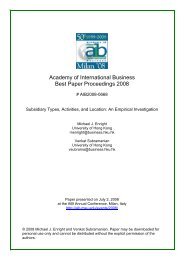AIB 2012 Conference Proceedings - Academy of International ...
AIB 2012 Conference Proceedings - Academy of International ...
AIB 2012 Conference Proceedings - Academy of International ...
Create successful ePaper yourself
Turn your PDF publications into a flip-book with our unique Google optimized e-Paper software.
SUNDAY<br />
Technology Sourcing and a 'Creative Transition' in Subsidiaries: The Case <strong>of</strong> MNE Operations in China<br />
Marina Papanastassiou, Copenhagen Business School<br />
Robert Pearce, University <strong>of</strong> Reading<br />
Si Zhang, Tsinghua University<br />
The paper focuses on a ‘creative transition' (CT) as a crucial tipping point in the strategic evolution <strong>of</strong> MNE<br />
subsidiaries. Before a CT a subsidiary's operations will be based around application (in a market-seeking or<br />
efficiency-seeking strategy) <strong>of</strong> the successful established technologies and products <strong>of</strong> the MNE group. After<br />
the CT (as, for example, a Product Mandate) the subsidiary will be deriving new sources <strong>of</strong> technology, notably<br />
from its host country, and developing new products from these. Thus, we argue, the sources <strong>of</strong> technology<br />
accessed and/or generated by a subsidiary are crucial in defining its competitive status. Evidence cited from a<br />
study <strong>of</strong> MNE subsidiaries in China demonstrates the value <strong>of</strong> the concept <strong>of</strong> CT. Though pre-CT operations <strong>of</strong><br />
an ES, export-oriented, nature have played a role in China it is shown that, to an increasing degree, it is now<br />
post-CT innovation that provides the dominant imperative. But, contrary to traditional Product Mandates, a<br />
major strand <strong>of</strong> this innovation targets an embedded position in China's growth for MNEs. (For more<br />
information, please contact: Marina Papanastassiou, Copenhagen Business School, Denmark: mpa.smg@cbs.dk)<br />
Session: 1.5.12 - Interactive<br />
Track: 8 - Developing Country MNCs<br />
Competitive Dynamics and Developing Economy Multinationals<br />
Presented On: July 1, <strong>2012</strong> - 16:15-17:30<br />
Chair: Luis Alfonso Dau, Northeastern University<br />
The <strong>International</strong>ization <strong>of</strong> Private and State Firms under Reforms<br />
Luis Alfonso Dau, Northeastern University<br />
Building on the institution-based view <strong>of</strong> strategy, we study the impact <strong>of</strong> pro-market reforms on developingcountry<br />
firm multinationality. We propose that reforms increase multinationality by reducing institutional<br />
imperfections and increasing domestic competition, thus inducing firms to expand internationally. However, we<br />
argue that the effect is higher for private firms than state firms because the former are compelled to be more<br />
responsive to institutional changes and opportunities in order to survive. The three-level RCM Poisson analyses<br />
<strong>of</strong> a panel <strong>of</strong> the largest firms in Latin America for the period 1989-2009 provide robust support for the<br />
arguments. (For more information, please contact: Luis Alfonso Dau, Northeastern University, USA:<br />
l.dau@neu.edu)<br />
Innovation Blowback - How Competition between Advanced Economy MNEs Raises Competitors from Emerging<br />
Markets<br />
Martin Ihrig, University <strong>of</strong> Pennsylvania<br />
Philip Kappen, Uppsala University<br />
This paper provides an evolutionary explanation to the rise <strong>of</strong> the emerging market MNE. It does so by<br />
presenting the innovation blowback framework which describes how competition between traditional advanced<br />
economy MNEs raises tomorrow's new competitors from emerging markets. In particular, the paper provides a<br />
formal model <strong>of</strong> trade-<strong>of</strong>fs that the advanced economy MNE faces when organizing its R&D activities either<br />
concentrated at home or geographically dispersed. Using the SimIntReDe s<strong>of</strong>tware, the model is subsequently<br />
evaluated by simulation in the SimISpace environment. The initial simulations lend support for the innovation<br />
blowback framework and the findings provide insights into the evolution <strong>of</strong> new competition, firm performance<br />
<strong>AIB</strong> <strong>2012</strong> <strong>Conference</strong> <strong>Proceedings</strong><br />
Page 92

















